All about Letraset's presses; here's one of three articles which, combined, should give you a detailed panorama of Letraset's Action Transfers & Instant Pictures — & related topics besides.
The main article is "A Brief History of Letraset & Action Transfers", & then "Printing: Dates & Serial Numbers" shows the detailed record of what, when, where & how; but here we're going to give you a good look at how these pesky transfers were actually printed — which, at least to start with, is quite different from how they are printed today. You'll also get to go on a very quick tour of the Ashford factory… & even get to see Action Transfers being printed & processed!
- There are four chapters in this article:
- Chapter One: Silkscreen (this page ↓)
- Chapter Two: Gravure →
- Chapter Three: Ashford →
- Chapter Four: Litho →
Chapter One: Silkscreen
Letraset's raison d'être was Instant Lettering, which was produced by monochrome silkscreen printing (although not necessarily always printed in blacK ink). Not wishing to remain a "one-trick pony" (as John Chudley put it), they were constantly searching for new avenues to explore. Moving into the market of products for children, it would have become very quickly apparent that monochrome transfers looked very old-fashioned beside traditional full-colour waterslide transfers. So the pressure was on from the beginning to move to colour.
Letraset printed their Kippax Silkscreen & later (from the Autumn of 1968 on) their Ashford Rotary Gravure transfers on sheets in the Imperial size known as Crown: 15" x 20" (381mm x 508mm).
Bill Kippax confirmed to me, after I got in touch with him having concluded as much from painstaking measurements & careful deductions: "The machine sold to Letraset in 1961-62 was a Kippax Pneuminor with a print area of 25" x 18"."

The enormous quantity of monochrome Instant Pictures were all printed on this solitary little press: Busy Bees, Panoramas, Waddington's Instant Pictures & the much later Joe 90 Magic Instant Picture Book; quite an achievement for such a small machine!
Bill Kippax replied to my comment that Letraset must have been very busy by saying that they were notorious in the industry for printing twenty-four hours per day. (An interesting but not very relevant snippet: he also sold a press to a company in Oxford who attempted to infringe Letraset's patent; I think this must have been Milford Astor, the company that produced 'Fingerprint' & whom Letraset later bought out for other reasons entirely.)
Four squares of Busy Bee transfers (7.5" by 10") fit neatly onto one sheet of Crown. Letraset Art Sheets are the same size. Monochrome Panorama transfers strips are 5" by 15", so four of them fit neatly onto one sheet of Crown. So far so good. Monochrome silkscreen printing doesn't require registration, just trim marks (because registration means accurately aligning two or more different colours, a situation which doesn't arise unless there is more than one colour). The reason they were divided into vertical strips (two per Panorama) was in order to fit them easily in the packing with the background, which was 3 feet wide (18" when folded).
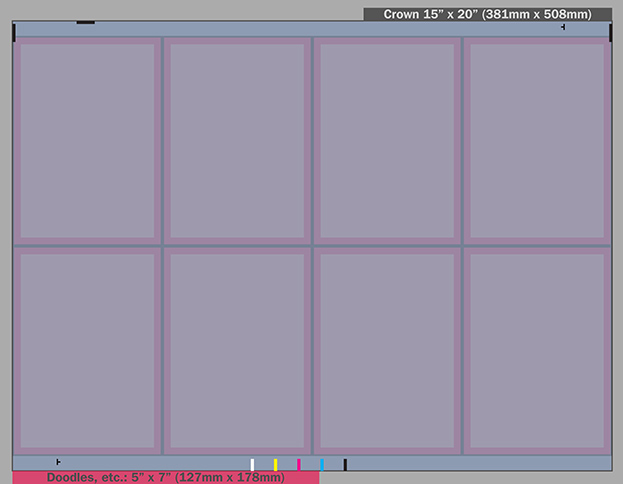
The registration marks shown are for a later gravure sheet, but the basic idea is the same: dividing a sheet of Crown into panels.
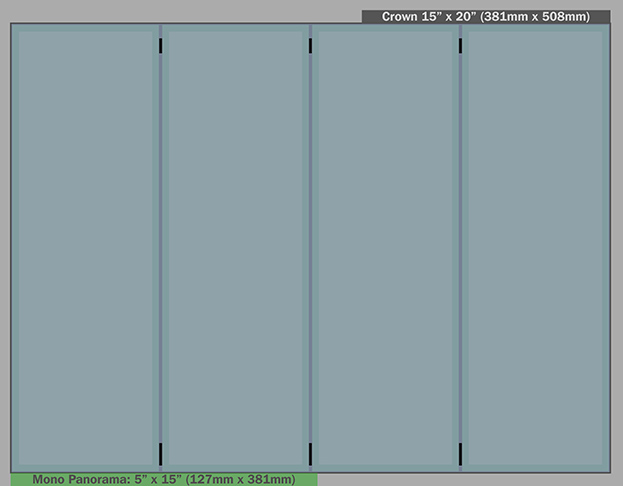
A sheet of Crown divided neatly into four strips of Panorama transfers. There are trim marks, but no registration marks are required.
The 'two-strip' format of the monochrome Panoramas was carried over to the 4-spot colour (2nd-run) Panoramas — let's call them "Mk.II" — but this gives a larger uncut sheet size for four transfer strips: 390mm x 600mm. That's 15.32" x 23.62", which is too large for a Crown sheet.
Then, when the monochrome transfers were reworked & reprinted as 4-spot colour (which I'll call "Revamps" for short) they were printed on square sheets instead of strips, with considerably fewer transfers than on the monochrome sheets. The implication is that the "Revamps" are later than the "Mk.II" 4-spots, but they can't be that much later or a better quality colour technique would probably have been demanded (unless Waddingtons had specifically requested consistent colour).
Monochrome Panorama strips (& almost all other silkscreen Letraset products) fit a sheet of Crown EXACTLY. So do all Letraset products after 1968 — that's the size used by their Gravure press. The problem is with the two groups of 4-spot colour silkscreen transfers: the "Mk.II" Panorama sheets (strips) & the "Revamps" Panorama sheets (squares). You will see that however you do it, there is a lot of wastage… hence the problem.
The recalcitrant sheet sizes:
"Mk.II" Panorama 4-spot: 390mm/15.32" x 600mm/23.62" [four strips]
"Revamps" Panorama: 428mm/16.85" x 508mm/20" [four squares]
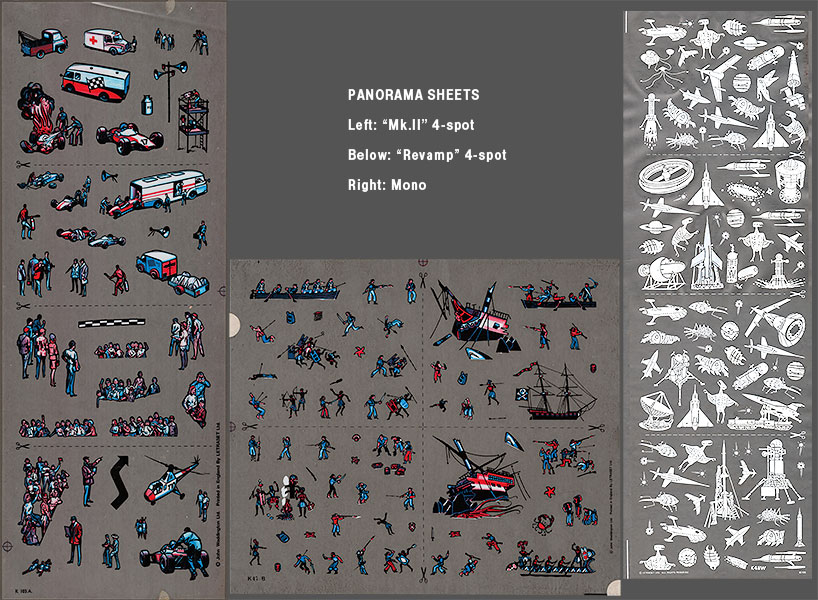
I came to the conclusion after a lot of juggling & experimentation that the first silkscreen press was Crown (an Imperial measurement) but that there must have been a second press using RA2, an European specification not yet common in the UK. I guessed this implied a Svecia…
Bill Kippax came to the rescue: "I am certain that Letraset bought a Svecia Semimatic after ours. They had a model 600mm x 440mm in their range. I do feel your paper sizes are correct, crown then RA2."
Letraset bought their Svecia press from Registerprint. The sheet size, which at RA2 was larger than Crown & therefore an 'upgrade', was 16.9" x 24" (430mm x 610mm). This provides room for four strips or squares, solving the mystery of why the few 4-spot transfers were printed on unusually large sheets.

Four transfer strips on a sheet of RA2 (Crown, clearly too small, also shown). Now there are several colours, so there are registration as well as trim marks.

Four panels on RA2 (Crown shown again for comparison). The marks are the same as above, but rotated 180º, since the artwork doesn't need to face 'up'.
The two Batman Panorama strips each appear to have been designed by different artists, although in fact both were by Peter Archer. The 4-spot Batman strip was divided into six panels rather than the customary four, & the 'scissors' lines were omitted; all this suggests the division of the sheet was designed to be factory-cut into cereal Free Gift sizes, for which reason each panel has its own title & copyright notice.
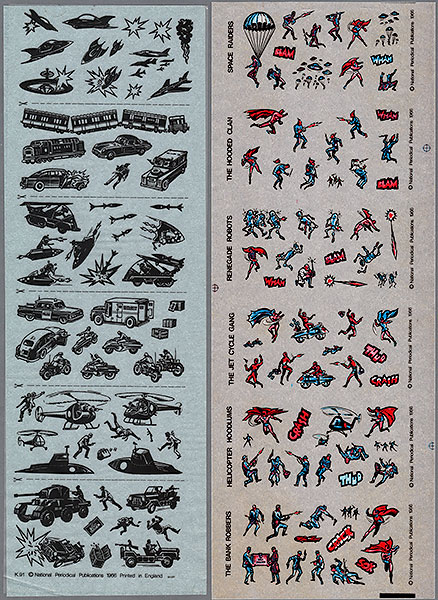
The sheet has its three registration marks within it, not spread across two sheets as has been customary hitherto. Normally Letraset print three registration marks, one each at bottom left, centre, & top right, of a pair of sheets (which co-incidentally makes it easy to see in retrospect which of the sheets went on the left & which on the right). Letraset also use a short, thick horizontal stripe of black along part of the top & bottom.
When the Nabisco promotion was repeated in Australia with Vita-Brits, instead of using the same transfers the artwork for the six panels was re-used at a smaller size with only three spot colours in place of four, & six new panels were created in the same style but by a new artist. Why this was done must presumably have been due to a whim of the client; these are the only 3-spot transfers Letraset ever printed for children.
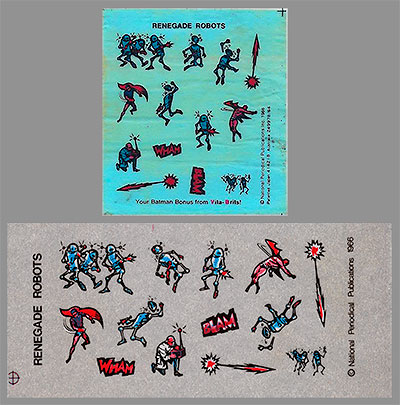
A curious fact about the Svecia press was that only about half a dozen Instant Pictures sheets were ever printed on it, as can be shown by laying out the known artwork on RA2 sheets.
- The Batman Free Gift transfers for Shredded Wheat (which were the Panorama sheet cut into six sections). No doubt this took up a whole sheet, with the artwork being repeated four times on the sheet.
- The Batman Free Gift transfers for Vita Brits — the twelve transfers exclusively for Vita Brits being smaller & in only 3-spot colour.
(N.B.: these may have been printed on the Kippax, since with only three colours, registration was less problematic.) - The "Mk.II" 4-spot Waddingtons Panorama sheets. One sheet would have been used for the 'Haunted House' & 'Fairytale Landscape' Panoramas together, since these were in fact 2-spot rather than 4-spot.
- The replacement "Revamps" sheets for the 1st run monochrome Panorama sheets (& the Waddingtons Mini Action Transfers which are those same revamp transfers repackaged).
- The Tarzan Panorama, which is not Red-Blue-blacK-White, but Red-Yellow-blacK-White. They are shown on the Panorama back as eight panels (with six of them numbered 1-6), which implies strip form rather than square.
That's not many transfers…
Of course, the Svecia press would have been used for other jobs requiring spot colours. Among these we can number sheets for model cars, trains & kits, & 'Special Sheets'. Letraset later specified that Special Sheets were Crown, but this was after moving to Ashford. There is one sheet which we know must have been printed before that, in 5-spot colour; S10064 — the Yellow Submarine. Either this must have been printed on the Svecia, or Special Sheets in multiple colours were already being printed on another, dedicated, press — which, although perfectly possible, seems unlikely.
Comparison of the sheet, using the photos available, with the relative aspect ratios of Crown & RA2 sheets suggests that it's the latter, so I think we have a winner. The Yellow Submarine film used this Special Sheet wherever the submarine itself appears onscreen at a fairly small size, & the sheet itself was RA2 in five spot colours, silkscreen printed on the Svecia press.
(The ratio of Crown is 0.75, RA2 is 0.7, & the sheets I've seen appear to be 0.69, which is as close as one might hope!)
After the move to Ashford, which was very soon after this sheet was produced, Letraset used their newly-purchased 'Hand Bench' silkscreen printers to produce Special Sheets — as you will see on the Ashford tour.
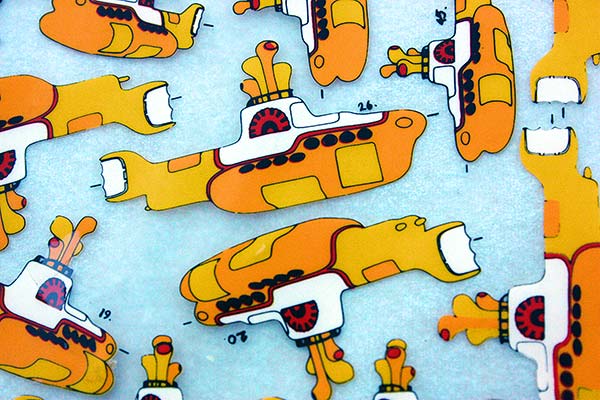
So that's the story of the two silkscreen presses which Letraset used to print all the Instant Pictures before April 1968. From that date, all their 'toy' transfers (apart from the two Joe 90 books) were gravure printed, right up to 1976 when everything moved to Italy & a litho press.
• Next Chapter: Gravure →
• See also: "A Brief History of Letraset & Action Transfers" →
• See also: "Printing: Dates & Serial Numbers" →
I am obliged to state that this document, the information contained within it, & its arrangement are all © Tom Vinelott 2007-2024.